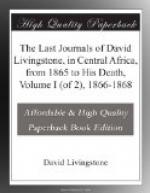Casembe’s smile was elicited by the dwarf making some uncouth antics before him. His executioner also came forward to look: he had a broad Lunda sword on his arm, and a curious scizzor-like instrument at his neck for cropping ears. On saying to him that his was nasty work, he smiled, and so did many who were not sure of their ears a moment: many men of respectability show that at some former time they have been thus punished. Casembe sent us another large basket of fire-dried fish in addition to that sent us at Chungu, two baskets of flour, one of dried cassava, and a pot of pombe or beer. Mohamad, who was accustomed to much more liberal Casembes, thinks this one very stingy, having neither generosity nor good sense; but as we cannot consume all he gives, we do not complain.
27th November, 1867.—Casembe’s chief wife passes frequently to her plantation, carried by six, or more commonly by twelve men in a sort of palanquin: she has European features, but light-brown complexion. A number of men run before her, brandishing swords and battle-axes, and one beats a hollow instrument, giving warning to passengers to clear the way: she has two enormous pipes ready filled for smoking. She is very attentive to her agriculture; cassava is the chief product; sweet potatoes, maize, sorghum, pennisetum, millet, ground-nuts, cotton. The people seem more savage than any I have yet seen: they strike each other barbarously from mere wantonness, but they are civil enough to me.
Mohamad bin Saleh proposes to go to Ujiji next month. He waited when he heard of our coming, in order that we might go together: he has a very low opinion of the present chief. The area which has served for building the chief town at different times is about ten miles in diameter.
Mofwe is a shallow piece of water about two miles broad, four or less long, full of sedgy islands, the abodes of waterfowl, but some are solid enough to be cultivated. The bottom is mud, though sandy at the east shore: it has no communication with the Luapula. (28th November, 1867.) The Lunde, Chungu, and Mandapala are said to join and flow into Moero. Fish are in great abundance (perch). On the west side there is a grove of palm-oil palms, and beyond west rises a long range of mountains of the Rua country 15 or 20 miles off.
1st December, 1867.—An old man named Perembe is the owner of the land on which Casembe has built. They always keep up the traditional ownership. Munongo is a brother of Perembe, and he owns the country east of the Kalongosi: if any one wished to cultivate land he would apply to these aboriginal chiefs for it.
I asked a man from Casembe to guide me to south end of Moero, but he advised me not to go as it was so marshy. The Lunde forms a marsh on one side, and the Luapula lets water percolate through sand and mud, and so does the Robukwe, which makes the path often knee deep. He said he would send men to conduct me to Moero, a little further down, and added that we had got very little to eat from him, and he wanted to give more. Moero’s south end is about 9 deg. 30’ S.




